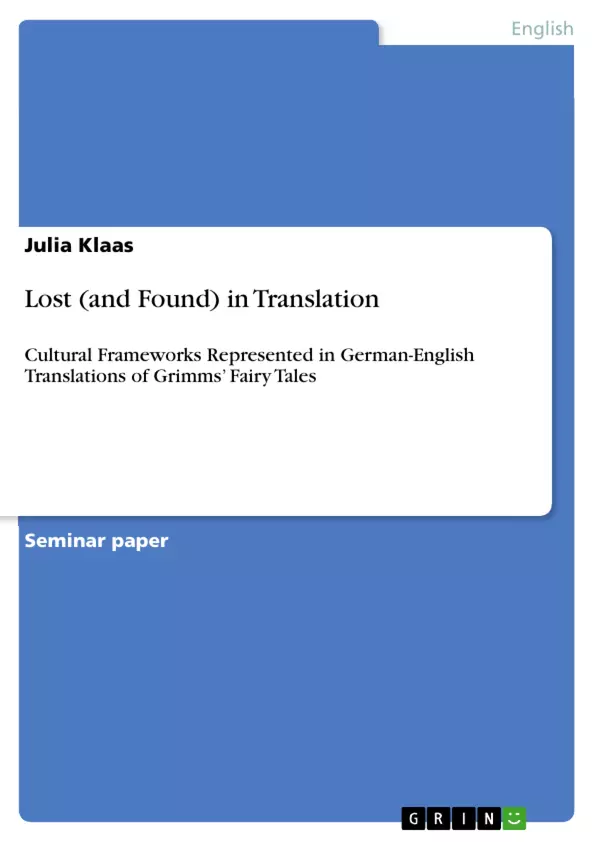Given the popularity of Grimms’ fairy tales and the status of English as a lingua franca, it is only logical that there are a number of translations and adaptations from German into English. This will be the focus of my paper, in which I am dealing with the cultural frameworks that underlie a translator’s decision to translate a well-known story in a certain way over another. In other words, why is it that Rumpelstiltskin does not burst in two halves in most English versions of the fairy tale? Why did Disney see the need to let a fairy godmother help Cinderella and not some kind-hearted doves? And why is it ‘true love’s kiss’ that awakens Snow White instead of the servants’ clumsiness while carrying the coffin?
"Something gets lost in translation, and in translating and editing these “rediscovered” tales I have endeavored to recast them as closely as I could to the originals. At the same time I felled compelled to provide transitions and slight changes to make them comprehensible for an English-speaking audience. Now, though in a foreign tongue, they speak for themselves – to provoke and to entertain."
This is how Jack Zipes introduces his translation of Grimms’ Kinder- und Hausmärchen, a collection of fairy tales compiled and edited by the German brothers Jacob and Wilhelm Grimm between 1812 and 1857. His take on the translation of Grimms’ fairy tales, easily the most famous collections of fairy and folk tales in the Western world, is one of the topics that I will be concerned with in the following paper. It is only “one” of the topics because every translator’s approach is different from all others, and while there are those like Zipes who want to stay as close to the original as possible and provide a ‘literal’ translation of a work, there are others who not only ‘translate’ the language of a story, but also its content, in order to fit more easily with the cultural background of the intended readership.
Inhaltsverzeichnis (Table of Contents)
- I. Publication and Translation History of Grimms' Kinder- und Hausmärchen
- II. German-English Translations of the KHM
- The Representation of Cultural Frameworks in the Translation of Fairy Tales
- Sneewittchen, Snow-drop and Snow White
- III. Conclusion
- IV. Works Cited
Zielsetzung und Themenschwerpunkte (Objectives and Key Themes)
This paper explores the cultural frameworks that influence the translation of Grimms' fairy tales from German to English, focusing on the adaptations and changes made in various versions of Snow White. The paper examines how translators and editors navigate the cultural context of the original tales and the intended audience, considering the impact of social and historical influences on the translation process.
- Cultural Frameworks in Translation
- Adaptation and Changes in Fairy Tale Translations
- Social and Historical Influences on Translation
- The Role of Audience and Intended Readership
- Comparing Different Translations of Snow White
Zusammenfassung der Kapitel (Chapter Summaries)
The first chapter delves into the publication and translation history of Grimms' Kinder- und Hausmärchen. It discusses the changes made by the Grimm brothers themselves over multiple editions, particularly the reduction of violence and disturbing elements to make the tales more suitable for a wider audience. The chapter explores the evolution of the intended readership from scholarly work to children's entertainment, highlighting the impact of social and cultural shifts on the content and presentation of the tales.
The second chapter focuses on the German-English translations of the KHM, specifically examining the representation of cultural frameworks in the translation of fairy tales. The chapter will use the example of Snow White to illustrate how different translators and editors adapt the story to suit the cultural norms and expectations of their intended audience.
Schlüsselwörter (Keywords)
The primary focus of this paper is on the translation of Grimms' fairy tales, specifically the impact of cultural frameworks on the translation process. Key themes include cultural adaptation, audience and readership, social and historical influences, and the comparison of different translations, particularly of the story of Snow White. The paper draws on examples from various translations and editions of Grimms' work, highlighting the dynamic relationship between cultural context and translation.
- Arbeit zitieren
- Julia Klaas (Autor:in), 2013, Lost (and Found) in Translation, München, GRIN Verlag, https://www.hausarbeiten.de/document/492530


